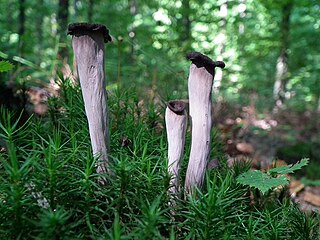
Craterellus is a genus of generally edible fungi similar to the closely related chanterelles, with some new species recently moved from the latter to the former. Both groups lack true gills on the underside of their caps, though they often have gill-like wrinkles and ridges.

Hygrophoropsis aurantiaca, commonly known as the false chanterelle, is a species of fungus in the family Hygrophoropsidaceae. It is found across several continents, growing in woodland and heathland, and sometimes on woodchips used in gardening and landscaping. Fruit bodies (mushrooms) are yellow–orange, with a funnel-shaped cap up to 8 cm across that has a felt-like surface. The thin, often forked gills on the underside of the cap run partway down the length of the otherwise smooth stipe. Reports on the mushroom's edibility vary – it is considered poisonous, but has historically been eaten internationally.
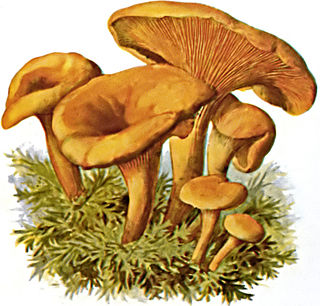
The Hygrophoropsidaceae are a family of mushrooms that are gilled in appearance but lie within the Boletales. The family contains 18 species within two genera: Leucogyrophana and Hygrophoropsis, with the best-known member being the "false chanterelle", Hygrophoropsis aurantiaca. Hygrophoropsidaceae was circumscribed by French mycologist Robert Kühner in 1980, with Hygrophoropsis as the type genus. Unlike most members of the Boletales, Hygrophoropsidaceae species are saprophytic wood-rotting fungi that cause brown rot in their hosts. The genera Austropaxillus and Tapinella, once placed in this family, are now classified in the Serpulaceae and Tapinellaceae, respectively.
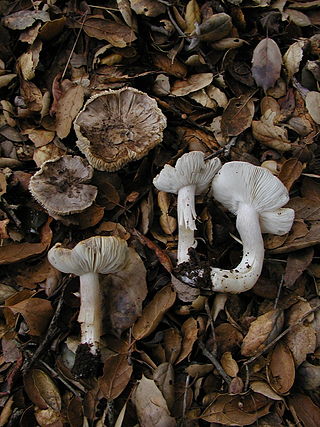
Tricholoma argyraceum is a grey-capped mushroom of the large genus Tricholoma. It has been often confused with the similar-looking Tricholoma scalpturatum.

René Charles Joseph Ernest Maire was a French botanist and mycologist. His major work was the Flore de l'Afrique du Nord in 16 volumes published posthumously in 1953. He collected plants from Algeria, Morocco, France, and Mali for the herbarium of the National Botanic Garden of Belgium.
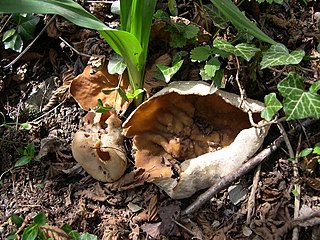
Disciotis is a genus of fungi in the family Morchellaceae. Members of this family, characterized by their cup- or bowl-shaped apothecia, have a widespread distribution, especially in northern temperate regions.

Conocybe rickenii is a mushroom from the genus Conocybe. Its edibility is disputed, and it has the appearance of a typical little brown mushroom with a small, conical cap, and long, thin stem. In colour, it is generally a cream-brown, lighter on the stem, and it has a thin layer of flesh with no distinct smell or taste. It is a coprophilous fungus, feeding off dung and it is most common on very rich soil or growing directly from dung. It can be found in Europe, Australia and Pacific islands.
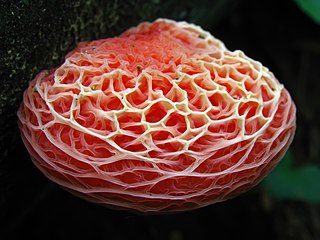
Rhodotus is a genus in the fungus family Physalacriaceae. There are two species in the genus with the best known, Rhodotus palmatus, called the netted rhodotus, the rosy veincap, or the wrinkled peach. This uncommon species has a circumboreal distribution, and has been collected in eastern North America, northern Africa, Europe, and Asia; declining populations in Europe have led to its appearance in over half of the European fungal Red Lists of threatened species. Typically found growing on the stumps and logs of rotting hardwoods, mature specimens may usually be identified by the pinkish color and the distinctive ridged and veined surface of their rubbery caps; variations in the color and quantity of light received during development lead to variations in the size, shape, and cap color of fruit bodies.

Hygrophoropsis is a genus of gilled fungi in the family Hygrophoropsidaceae. It was circumscribed in 1888 to contain the type species, H. aurantiaca, a widespread fungus that, based on its appearance, has been affiliated with Cantharellus, Clitocybe, and Paxillus. Modern molecular phylogenetic analysis shows that the genus belongs to the suborder Coniophorineae of the order Boletales.

Leucoinocybe is a fungal genus in the family Tricholomataceae. This genus is known to contain 3 species: Leucoinocybe lenta and Leucoinocybe taniae, found in Europe, and Leucoinocybe sulcata found in India.
Dactylosporina is a genus of fungi in the family Physalacriaceae. D. brunneomarginata, the first representative of the genus found in Asia, was added to Dactylosporina in 2015.

Clavaria is a genus of fungi in the family Clavariaceae. Species of Clavaria produce basidiocarps that are either cylindrical to club-shaped or branched and coral-like. They are often grouped with similar-looking species from other genera, when they are collectively known as the clavarioid fungi. All Clavaria species are terrestrial and most are believed to be saprotrophic. In Europe, they are typical of old, mossy, unimproved grassland. In North America and elsewhere, they are more commonly found in woodlands.
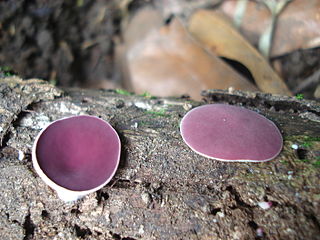
Phillipsia is a genus of fungi in the family Sarcoscyphaceae. There are about 17 species in the genus, which collectively have a widespread distribution in subtropical and tropical areas. The genus was circumscribed by Miles Joseph Berkeley in 1881. The generic name honours Wales-born English botanist William Phillips (1822–1905).
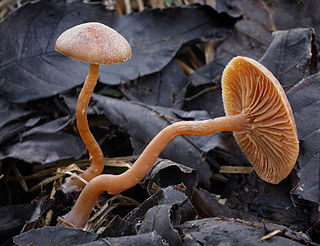
Tubaria is a genus of fungi in the family Tubariaceae. The genus is widely distributed, especially in temperate regions. Tubaria was originally named as a subgenus of Agaricus by Worthington George Smith in 1870. Claude Casimir Gillet promoted it to generic status in 1876. The mushrooms produced by species in this genus are small- to medium-sized with caps ranging in color from pale pinkish-brown to reddish-brown, and often with remnants of the partial veil adhering to the margin. Mushrooms fruit on rotting wood, or, less frequently, in the soil. There are no species in the genus that are recommended for consumption.
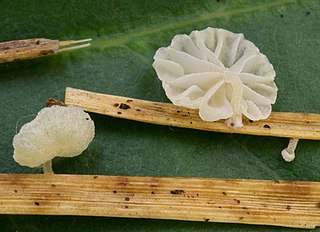
Resinomycena is a genus of fungi in the mushroom family Mycenaceae. The genus contains at least eight species found in North America, Europe and eastern Asia. This genus of small white to tan colored agarics is saprophytic and colonizes leaf litter, bark, small twigs and decaying monocot vegetation. The fruitbodies are small and resemble Mycena or Marasmius or Hemimycena and are distinguished by amyloid spores, poorly dextrinoid tissues, and the abundant oily, resinous cystidia on the pileus, lamellae edges and stipes. One recently described species, Resinomycena fulgens from Japan that is a synonym of Resinomycena japonica, has luminescent fruitbodies.

Mycena arcangeliana is a species of Mycenaceae fungus. It has been known by a number of scientific names, and its taxonomy is still somewhat disputed. It produces small mushrooms with caps varying in colour from whitish to a darker grey-brown, and stems of an olive-greyish that fade with age. The mushrooms can be mistaken for the similar Mycena flavescens. They have a mild taste, but a strong smell of iodoform; they are not edible. The species grows on dead wood in autumn months, and can be found throughout Europe.
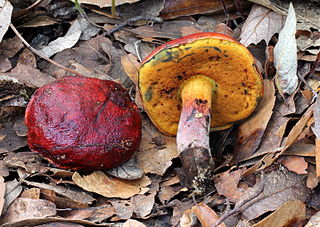
Rubroboletus dupainii, commonly known as Dupain's bolete, is a bolete fungus of the genus Rubroboletus. It is native to Europe, where it is threatened, and red listed in six countries. It also occurs in North America, although it is rare there. It was first recorded from North Carolina, and then from Iowa in 2009. It was reported from Belize in 2007, growing under Quercus peduncularis and other oaks.
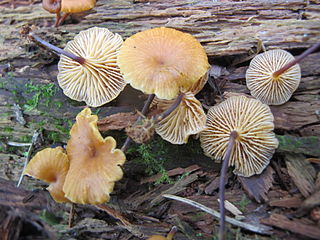
Xeromphalina cauticinalis is a species of agaric fungus in the family Mycenaceae. Originally described in 1838 by Elias Fries as Marasmius cauticinalis, it was transferred to the genus Xeromphalina by Robert Kühner and René Maire in 1934. It is found in North America, where it fruits in the summer and autumn singly or in groups on the seeds, needles, and sticks of conifers, and sometimes on aspen leaves. The fruit bodies have convex yellowish caps measuring 0.5–2.5 cm (0.2–1.0 in) in diameter supported by a tough yellow-brown to dark brown stipe that is 3–8 cm (1.2–3.1 in) long by 1–2.5 mm thick. The pale yellow gills have a decurrent attachment to the stipe and are somewhat distantly spaced. The spore print is white, while individual spores are elliptical, smooth, amyloid, and measure 4–7 by 2.5–3.5 µm.

Lentinellus vulpinus is a species of fungus belonging to the family Auriscalpiaceae.


















